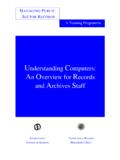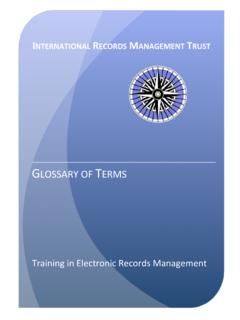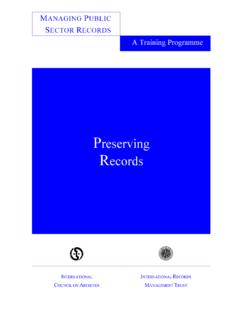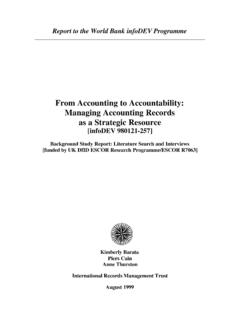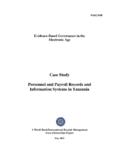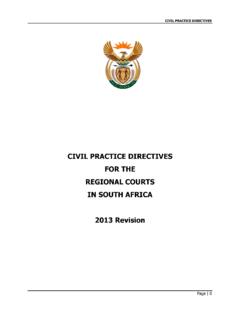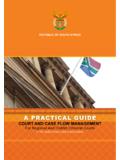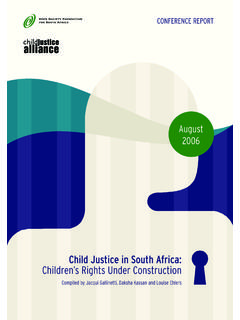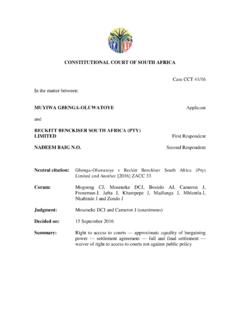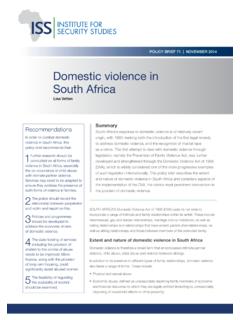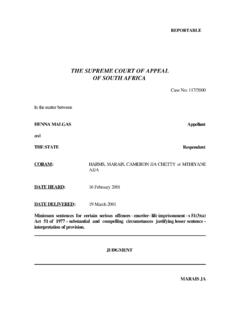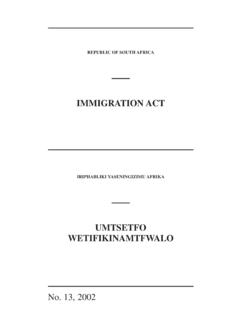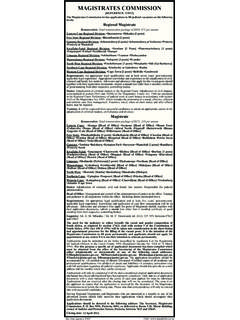Transcription of Case Study Legal and Judicial Records and …
1 WB/CS/05 Evidence-Based Governance in the Electronic Age Case Study Legal and Judicial Records and information Systems in south africa This case Study has been prepared by the International Records Management Trust and does not reflect the views of the World Bank nor the Government of south africa . A World Bank/International Records Management Trust Partnership Project July 2002 WB Case Studies/4884wbcs05 CONTENTS Introduction 1 Executive Summary 2 Judicial system and Institutions 5 Records Management in the Courts 10 Integrated Justice system (IJS) and E-Justice 12 Court Processes and record Keeping Systems 16 Court Process Project 29 Role of the National Archives and Records Service 35E-Government and Electronic Records Management 37 Records and information Management: Key Issues 38 Appendix A: List of People Consulted 41 Appendix B: Access to information 42 1 Situation current as of July 2002 INTRODUCTION 1 Evidence-Based Governance in the Electronic Age is a three-year project delivered in partnership between the World Bank and the International Records Management Trust.
2 It involves coordinating a global network of institutions and organisations to facilitate the modernisation of information and Records systems. 2 Records , and the information they contain, are a valuable asset that must be managed and protected. Records provide the essential evidence that a particular action or transaction took place or that a particular decision was made. Records support all business functions and are critical to the assessment of policies and programmes, and to the analysis of individual and organisational performance. Without reliable Records , government cannot administer justice and cannot manage the state s resources, its revenue or its civil service. It cannot deliver services such as education and health care. Without accurate and reliable Records , and effective systems to manage them, governments cannot be held accountable for their decisions and actions, and the rights and obligations of citizens and corporate bodies cannot be upheld.
3 3 New technologies provide great potential to improve services and efficiency, but the evidence base upon which governments depend must continue to be protected and preserved. For initiatives such as e-government and e-commerce to be successful, governments must have access to information that possesses certain crucial characteristics: the information must be available, accurate, relevant, complete, authoritative, authentic and secure. 4 The aim of the Evidence-Based Governance project is to make Records management a cornerstone of the global development agenda. The challenge is to rebuild and modernise information and Records management systems in parallel with complementary measures to improve the broader environment for public sector management. The project represents a major opportunity to integrate Records management into global strategies for good governance, economic development and poverty reduction.
4 5 During the first phase of the project, studies were carried out within the World Bank and in a range of countries to explore the requirements for managing personnel, financial and Judicial Records in a hybrid, electronic/paper environment. This report is one of thirteen case studies that illustrate the issues involved. The studies have been supplemented by findings derived by a global discussion forum involving senior officials and Records and archives professionals. The knowledge gathered through these means is providing the basis for the development of assessment tools to measure the quality of Records and information systems in relation to clearly defined functional requirements and benchmarks. The project will develop tools for use in the three areas of Study : personnel, financial and Judicial Records systems. Ultimately, the information gathered will also help to define the requirements for global capacity building for managing electronic Records .
5 6 The case studies have been chosen to represent differences in geographic regions, administrative structures and resource environments. The management of Legal and Judicial Records has been examined in Argentina, Ecuador, The Gambia, Singapore 2 Situation current as of July 2002 and south africa . These countries give a broad geographical spread and represent different degrees of development in financial reform and the use of electronic Records . 7 This report covers a visit to south africa by Andrew Griffin and Kelly Mannix from 22 to 26 July 2002. The purpose of the visit was to examine the improvements to Records and information systems that are being undertaken by the Judiciary in south africa . A secondary purpose was to test the prototype of an assessment tool for Legal and Judicial Records and information systems. Findings from the case Study are being used to develop the assessment tool.
6 The assessment tool will be published separately from this report. 8 The case Study represents a snapshot in time. The observations it contains were current as of July 2002. Since then, new developments and improvements have taken place on a regular basis and therefore the case Study does not represent the situation at present. It is hoped that the findings in this report will highlight issues that will continue to arise in many other situations. Acknowledgements 9 Grateful thanks are extended to all those who assisted with the visit and provided information on the various initiatives and projects discussed. Particular mention goes to staff of the National Archives and Records Service (NARS) and the Department of Justice for their co-operation and assistance. A full list of people consulted is at Appendix A. EXECUTIVE SUMMARY 10 The 1996 Constitution of the Republic of south africa established a unified Judicial system that comprises the Constitutional Court; the Supreme Court of Appeal; the High Courts; the Magistrates Courts; and any other court established in terms of an Act of Parliament.
7 All courts function in terms of national legislation, and their rules and procedures must be provided for by national legislation. The National Prosecuting Authority (NPA) was established in 1998 as part of the Department of Justice and became an independent authority in April 2001. Under the NPA, Public Prosecutors institute and conduct criminal proceedings on behalf of the state. The Department of Justice and Constitutional Development is responsible for administering the courts and for constitutional development. It performs these functions in conjunction with judges, magistrates, the National Director of Public Prosecutions and Directors of Public Prosecutions. (paras 21 to 27 and Appendix B) 11 The transformation of the justice system is one of the greatest challenges facing the government.
8 The Department of Justice is undergoing a restructuring process. One of the goals is to improve service delivery and to ensure that the business of the courts is conducted efficiently and cost-effectively. This includes improving the productivity of the courts and making justice more accessible and affordable. Integration of the justice systems in the independent homelands has been a difficult process. Document control is poor in some homelands, and procedures are not always followed. The Department of Justice has granted traditional leaders powers to 3 Situation current as of July 2002 become commissioners of oath, with the intention of bringing justice services closer to rural communities. (paras 28 to 29) 12 Court and Legal structures are described in detail. These include: superior courts (the Constitutional Court, the Supreme Court of Appeal and the High Courts); regional and district courts; chief s courts; family court centres; the National Prosecuting Authority; and other Legal and Judicial bodies, such as the south African Law Commission and the Truth and Reconciliation Commission.
9 Pressures on the courts are discussed. (paras 30 to 56) 13 Each court or group of courts (criminal, civil, etc) is responsible for its own Records . Records management is seen as an integral part of the management of court business, not as a separate skill or discipline. Day-to-day guidance on the management of court Records , the use of forms, and other matters is provided in codified Instructions on Archives , issued by the Department of Justice. The responsibilities of the National Archives for managing the nation s Records are also set out in the Instructions. The Instructions appear to have limited use and predate the constitutional changes in south africa . Automation of court processes and record keeping systems is being introduced or developed, sometimes independently. (paras 57 to 63) 14 Opinions vary on the issue of the disposal of court Records .
10 High Court cases in Pretoria are kept by the Court for 20 years and then transferred to the National Archives. However, the National Archives is constrained by limited storage space and questions whether permanent preservation of all High Court Records is justified. The National Archives has advised the Department of Justice of the need to update retention and disposal schedules. Staff of the State information Technology Agency (SITA) and Department of Justice state that disposal instructions should be the same for electronic Records as they are for paper Records . However, this aspect of electronic Records management will need more thought. (paras 57 to 63) 15 At the national level, the e-justice programme began with the aim of introducing an Integrated Justice system (IJS). An Integrated Justice system Board was established in 1997 to integrate the activities of the Legal and Judicial sector.

